Just a final post for the last day in Santiago, then on to northern Peru….
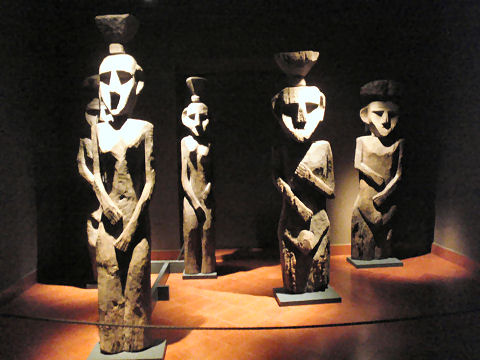
Started the day with a visit to the Museo del Arte Precolombino, hmm, it occurs to me that so often I hear from Latin Americans how much they dislike the whole conquistador thing which they lay the beginning of at the feet of Christopher Colombus, but how many things are referred to in pre and post his time period… Anyway, fascinating, if small museum, that covers quite succinctly many of the most important cultures in Latin America. Organized into rooms that cover geographic regions from north to south and then east, so starting in Mexico with the Mayans and their contemporaries, moving into a very small section on Central America, then Colombia, Ecuador, Peru, Chile, Argentina, and then up across the Amazon basin into Brazil. Spent most of the morning there.
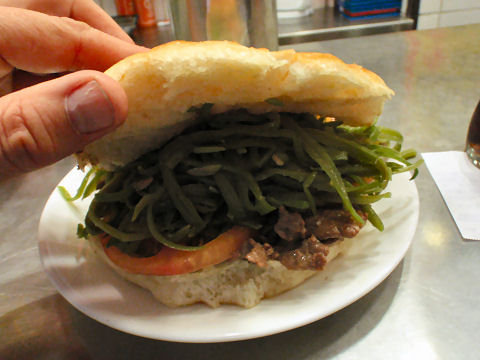
By which time it was the moment for a sandwich, this time a chacarero – thinly sliced, tender beef sirloin, topped with fresh tomatoes, blanched and slivered green beans, and in its true form, slices of fresh green chilies, though all the places I found in the downtown area only had hot sauce available to be added as you liked. Picking one of the many fast food sort of stands seemed an impossible task, so I simply asked the person most likely to know where to get the best cheap grub – the police officer at the corner of the Plaza de las Armas – who directed me to Ravera, one of a series of several stands along one side of the plaza that seems to be the spot for quick eats – each stand was packed with its own devotees. The sandwich, delicious, though the hot sauce could have been a whole lot hotter for my tastes.
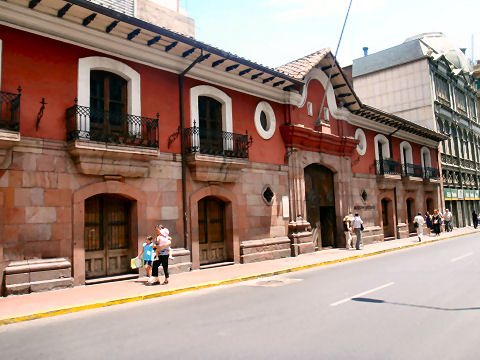
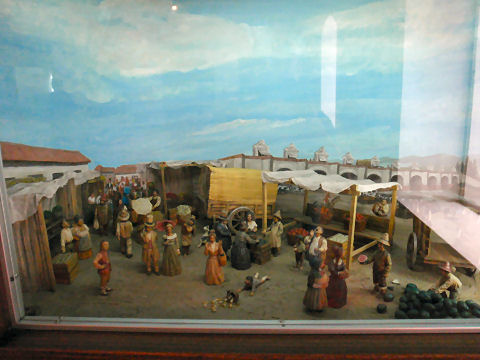
On to the Casa Colorado, a former government house which is now the municipal museum for Santiago – mostly filled with interesting little dioramas of early Santiaguena life.
Then… back to the mercado central because I just couldn’t stay away, and some close ups on some of the weird creatures people asked me about…
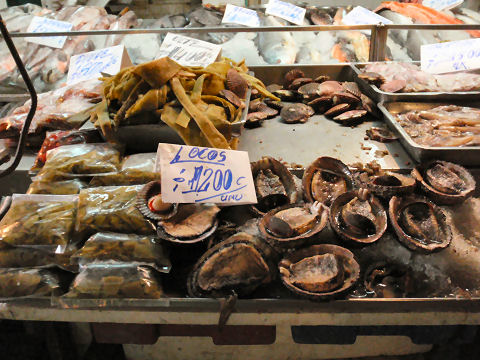
Locos, the Chilean abalones or false abalones; and behind them, those pale brown shafts, the ulte, a type of kelp.
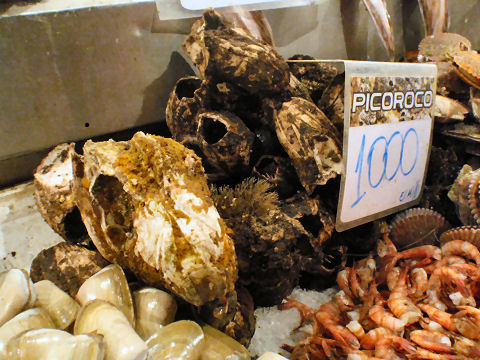
Picorocos, which I believe are a type of barnacle.
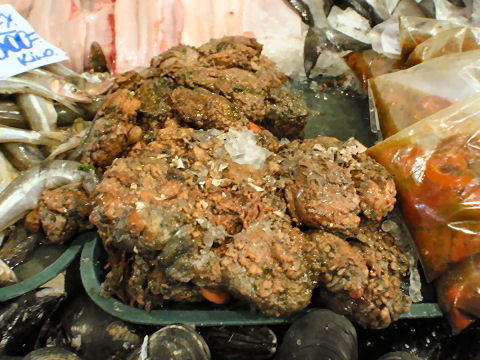
And the truly ugly, at least in their collapsed form, piures, or sea squirts.
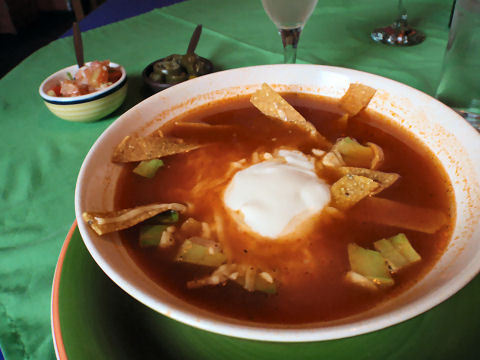
On the recommendation of Wayne, of the Moon Guide, I decided on a night out for something a little more picante, and Plaza Garibaldi, a Mexican-Chilean spot run by a woman who worked in Mexico and later as Salvador Allende’s chef. The food, pretty authentically Mexican, certainly better than anything I’ve eaten in BA in a long time. Here, Sopa de Azteca – delicious! And plenty spicy.
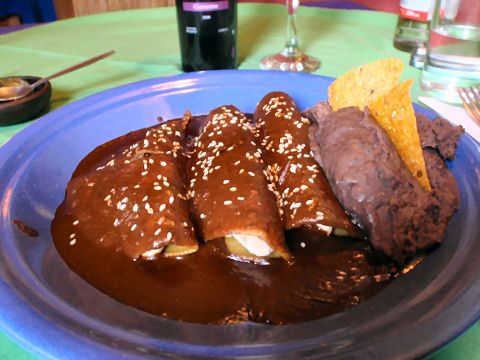
And, slightly less exciting, the Enchiladas con Mole – the sauce just a little too sweet for my tastes, and lacking in chilies, but the kitchen sent out a bowl of jalapeños to add to the plate and I was perfectly happy. A nice end to my Santiago adventure, if not particularly Chilean.
Glad to hear you liked Garibaldi – I’m always a little reluctant to recommend Mexican food outside Mexico, but Santiago has a much better selection than Buenos Aires does.
Regarding the picoroco, Texas food writer Robb Walsh wrote an article on it a several years ago in Natural History magazine, and it is indeed a giant barnacle. There’s a chapter about Chilean seafood in his book Are You Really Going to Eat That? , which you can do a search on Google for (the URL is very long). He refers to piure as looking like a “dirty sponge.” I have eaten picoroco, but I can’t say it was my favorite. I do love locos, especially in the form of chupe de locos.
, which you can do a search on Google for (the URL is very long). He refers to piure as looking like a “dirty sponge.” I have eaten picoroco, but I can’t say it was my favorite. I do love locos, especially in the form of chupe de locos.
Love what you are doing with your life. Hopefully it will inspire others to do it. There is something magical about leaving your backyard…I know it doesn’t make sense, not supposed to. Anyway, I do love what you are doing, but, I needed to somehow voice my opinion about something you wrote:
When I read this, at first, I got mad, then, I saw it for what it was, and then, I became sad. Sad because I totally see your point, I see your perspective. But I also know that looking at that same idea from a different angle, one lets say you had no choice but to assume; it was not the indegenous cultures of AMERICA LATINA that willingly chose to adopt a way of living, of looking at the world, of feeling and believeing that wasn’t theirs to begin with. The sadness of the story is in the fact that our ancestors did not have a choice.
So, as an ever so proud Colombian, please understand that Conquistador, to our innert most self, sounds lique slave owner. Black people also had not choice in that regard. Yes, I’m talking about slavery.
It is all the same…all of it. So sad we can’t see it.
Enjoy the rest of your adventure, I truly wish I could be traveling right now. If you want to find one of the many jewels of South America, go to Colombia! You will not regret it. If you do, I”m sorry 🙂
Santiago
Santiago,
Of course it was not their choice, it was one forced upon them. The same with conquered/slave cultures in all parts of the world. What is, as you say, sad, is that so many things are still organized around those events. For example in a museum such as this, especially one dedicated to local culture, why organize the whole exhibit around the dates of what the Spanish conquistadors and later settlers were doing? Yes, obviously, that time period had a major impact on culture, and things changed radically, so there’s a certain natural “break” if you will.
But I think, if indigenous (or first peoples or whichever term is currently in vogue) cultures want to reclaim their heritage, they need to start treating that period as simply another event in their history. As long as they give so much power to it, it will continue to dominate their lives. Organize museums and exhibitions around events that they’re proud of in their culture, not the lowest moments.
Much the same thing was (and probably still is for some) a big part of the black culture in the U.S., as you brought up – when I was a kid, 40-50 years ago, in the midst of the big civil rights movement in the U.S. there were always references to very specific events that seemed to be defining black culture in many ways, or at least the conversation about it – the era of slavery, and then the civil war and end of slavery. I think it wasn’t until the conversation turned to look at the future rather than continually dwelling in those past events as defining, that movement forward truly began. Martin Luther King’s famous speech was “I have a dream that one day…” not, “I had a nightmare about what happened 500 years ago…” One shouldn’t forget those events of the past, but there comes a point in the development of the future where it’s time to look forward, not back. The same is true for our Native American culture.
When you find a culture, of any sort, that seems stuck in the past, it very likely is – the underlying conversation is about the past, rather than the future. Those cultures that move forward are those that alter the core conversation to one of the future and what’s possible.
que rico todo!!!!!!!!!!! 😀
[…] mentioned back in my posts in Santiago that I really loved the chacarero sandwich – thin sliced beef cooked until tender in a beef and onion broth, served steaming on a bun […]